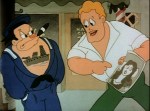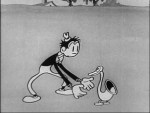You are currently browsing the tag archive for the ‘melodrama’ tag.
Directors: Ben Hardaway & Cal Dalton
Release Date: July 9, 1938
Rating: ★★½
Review:
 Love and Curses’ is set during the gay nineties and is a spoof of the classic melodrama, complete with mustached villain, a train track and a sawmill.
Love and Curses’ is set during the gay nineties and is a spoof of the classic melodrama, complete with mustached villain, a train track and a sawmill.
Unfortunately, the cartoon is hampered by the stiff melodramatic dialogue and the slow timing. Most of the ‘humor’ comes from the invincible hero Harold reciting proverbs all the time, but his appearances are tiresome, not funny. There are also a couple of throwaway gags, but these are mildly amusing at best.
This is one of those rather rare cartoons (not counting Popeye) featuring adult human designs, and the results are pretty unsteady. The animation of the girl singing at the nightclub is the most elaborate, but none of the animation is convincing.
Chuck Jones would visit the same kind of material four years later with ‘The Dover Boys‘, which seems light-years ahead of this cartoon.
Watch ‘Love and Curses’ yourself and tell me what you think:
http://www.dailymotion.com/video/xu5lrc
‘Love and Curses’ is available on the DVD-set ‘The Busby Berkeley Collection’
Directors: John Foster & George Stallings
Release Date: December 9, 1932
Stars: Tom and Jerry
Rating: ★★★★½
Review
 ‘Pencil Mania’ arguably is Tom and Jerry’s most inventive short of all.
‘Pencil Mania’ arguably is Tom and Jerry’s most inventive short of all.
In this short Jerry has a magic pencil with which he can draw things in mid-air, which immediately come to life. This leads to some surreal gags with a lot of metamorphosis being involved. It’s for example fascinating to watch a saxophone change into a duck.
Unfortunately, as soon as Jerry has drawn three melodrama figures, the short turns to their antics. Nevertheless, the finale is mesmerizing: a complete train disappears into nothing, and Jerry breaks through the paper to make the heroin return to his pencil before Tom can kiss her. Gags like these, breaking the 4th wall, were extremely rare in 1932, making ‘Pencil Mania’ pretty unique. At any rate it’s very enjoyable to watch, even though the train is the only well-drawn thing in the entire short. One can only guess what more able hands could have made out of a story idea like this.
Eight years later Terrytoons would use the same idea in the Gandy Goose cartoon ‘The Magic Pencil’ (1940). No doubt the Terry animators had seen ‘Pencil Mania’, because not only do the two cartoon share a melodrama sequence, the magic also starts with the same gag: that of the Jerry/Gandy Goose drawing an egg, which falls on Tom’s/Sourpuss’s head. Moreover, both Jerry and Gandy Goose turn a door into a car, and like Jerry, Gandy makes the heroin flow back into his pencil.
‘Pencil Mania’ features three songs: Rudy Wiedoeft’s Saxophobia (1919), the 1923 hit ‘Yes, We Have No Bananas’, and ‘You’ve Got Me in the Palm of Your Hand’.
Watch ‘Pencil Mania’ yourself and tell me what you think:
This is Tom & Jerry cartoon No. 18
To the previous Tom & Jerry cartoon: Piano Tooners
To the next Tom & Jerry cartoon: Tight Rope Tricks
‘Pencil Mania’ is available on the DVD ‘The Complete Animated Adventures of Van Beuren Studio’s Tom and Jerry’
Director: Chuck Jones
Release Date: September 19, 1942
Rating: ★★★★★ ♕
Review:
 ‘The Dover Boys’ or, as it is actually called, ‘The Dover Boys at Pimento University or The Rivals of Roquefort Hall’, is director Chuck Jones’s first masterpiece.
‘The Dover Boys’ or, as it is actually called, ‘The Dover Boys at Pimento University or The Rivals of Roquefort Hall’, is director Chuck Jones’s first masterpiece.
The short introduces his trademark of extreme poses, which in this cartoon are combined with ‘smear animation’ to unique results.
The extreme posing leads to highly stylized animation, which in itself is hilarious in its unnatural depiction of movement. In ‘The Dover Boys’ we watch both movement through poses, especially in the animation on Dan Backslide, as well as non-movement, with Dora descending the stairs as a prime example. Both techniques are important steps away from the classic squash-and-stretch animation, and from ‘believability through full animation’. Indeed, the animation style of ‘The Dover Boys’ looks forward all the way to the fifties, the era in which stylization of design and animation would flourish and dominate the animation industry. Indeed, the short’s prime animator, Bobe Cannon, would play an important role at UPA, the most influential animation film studio of the fifties.
The subject of ‘The Dover Boys’ is a sophisticated parody on melodrama, consisting of an archetypical story of a villain (called Dan Backslide) kidnapping a damsel in distress (dear Dora), taking her to his cottage in the mountains, where she is rescued by the heroes, in this case, the three Dover Boys, Tom, Dick and Larry.
Or is she? In the final scene they knock each other out, and Dora runs off into a distance with an odd bearded character in a bathing suit, who, as a running gag, hops along rather randomly throughout the picture to the music of ‘The Good Old Summertime’. This character is a relative of the equally mysterious Minah Bird from Chuck Jones’ earlier cartoon ‘Inki and the Lion’ (1941).
‘The Dover Boys’ is both innovative and funny. Its humor is as sophisticated as it is silly. In any case, the gags come fast and plenty, with hilarious nonsense as a result. An all time classic.
Watch ‘The Dover Boys’ yourself and tell me what you think:
Director: Walt Disney
Release Date: August 7, 1928
Stars: Mickey Mouse, Minnie Mouse, Pete
Rating: ★★★★★ ♕
Review:
Although Mickey’s first cartoon, ‘Plane Crazy‘, couldn’t arouse any distributor, Disney made another cartoon with his new character, ‘Gallopin’ Gaucho’. It was to be Mickey’s second and last silent cartoon.
If possible, he is even ruder in this short than in ‘Plane Crazy’: according to a poster in the background, he is a sought-after criminal, we watch him smoking and drinking, and dancing a stout tango with Minnie (who’s wearing a bra in this cartoon).
Nevertheless, this cartoon is also the first in which Mickey shows to be a small, but clever and courageous hero. For when Minnie is abducted by Pete (who, in his first appearance in a Mickey Mouse cartoon, has both his legs), Mickey rescues her in a heroic fight. He then earns the kiss he tried to get by force in ‘Plane Crazy’. It was of course this character trait which was greatly expanded upon in later Mickey Mouse cartoons. Mickey’s nemesis, Pete, was in fact a much older character than Mickey – he already figured in some of the Alice cartoons and he was also Oswald’s adversary. His design was initially more dog- or bearlike, but in the Mickey Mouse cartoons it was settled that Pete was some kind of big cat.
Due to the melodrama ‘Gallopin’ Gaucho’ contains less gags than ‘Plane Crazy’, but it’s still a wonderful and fast cartoon with ingenious gags like the scene in which Mickey uses his own tail as a tackle. ‘Gallopin’ Gaucho’ also set out a storyline that was to be copied a couple of times (e.g. ‘The Cactus Kid‘ (1930), ‘Mickey in Arabia‘ (1932),’ The Klondike Kid‘ (1932)), and self-consciously parodied in ‘Gallopin’ Romance’, the film shown in ‘Mickey’s Gala Premier’ (1933). ‘Gallopin’ Gaucho’ itself was a parody of the 1927 Douglas Fairbanks film ‘The Gaucho’.
This cartoon was de facto the first production of Disney’s new fledgling studio (‘Plane Crazy’ was made secretly when Disney was still under Mintz’s contract). Ub Iwerks, who had animated ‘Plane Crazy’ single-handedly, could now be assisted by the young assistant animators Les Clark and the recently hired Wilfred Jackson to work on ‘Gallopin’ Gaucho’. Both men would have long lasting careers at the Disney studio.
Unfortunately, ‘Gallopin’ Gaucho’ didn’t stir the distributors any more than did ‘Plane Crazy’. Disney had to come with something original, if he would get Mickey on the screen. And with something original he came…
A few final trivial remarks
- Mickey has shoes in this cartoon, which he shortly looses while whistling his ostrich in one scene.
- Mickey’s eyes change from the goggly to the familiar ones during the same scene.
- The bird Mickey’s riding might very well be a Rhea, a relative of the ostrich, that lives on the pampas of Argentina, the place where the cartoon takes place.
Watch ‘Gallopin’ Gaucho’ yourself and tell me what you think:
This is Mickey Mouse cartoon No. 2
To the previous Mickey Mouse cartoon: Plane Crazy
To the next Mickey Mouse cartoon: Steamboat Willie



